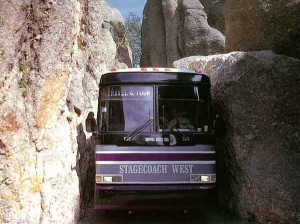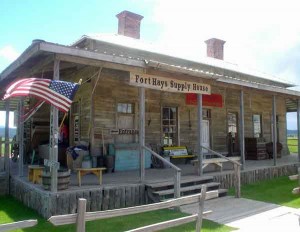
By Glenn Swain

The convergence of an Academy Award-winning film and a bus tour operator led to one of the more interesting travel tour destinations in South Dakota. Herman Jones, owner of Mount Rushmore Tours and a reminder of the rugged Old West individualism, forged his longtime dream of building a working town square with the remnants of the original movie set for Kevin Costner’s 1989 film, “Dances with Wolves.”
The two met when the actor came to the Black Hills to begin filming. By coincidence, Costner had leased the old homestead that belonged to Jones’ great-grandfather for the site for the movie. Costner needed buses to transport work crews and called on Jones, who came up with three school buses for the job.
After the shooting had ended Costner wanted to simply tear down the set and donate the lumber. But that was before the movie entered theaters and became a smash hit, earning an Oscar and a Golden Globe. Sensing an opportunity, then-Governor George Mickelson halted the razing of the buildings in an effort to capitalize on the movie set to promote South Dakota tourism.
When it became evident tourists showed less than expected interest in the remains of a movie set, and after a discussion of even burning the set to the ground, Jones purchased the buildings and moved them to his five-acre property 13 miles away from Rapid City to create Fort Hays, his working turn-of-the-century town square.
Fort Hays and the town square has become the focal point of Mount Rushmore Tours. Jones got the idea to have his own functional town after visiting Knott’s Berry Farm in 1967.
“I always wanted to put something together that people could see when they come to South Dakota,” he says.
Visitors to Fort Hays mingle in the town square where a blacksmith makes knives, and shops where tourists make their own tin plates, bricks and twine lasso ropes. A working saw mill is among the attractions. Supper is served in the evenings and a cowboy band provides live entertainment.

Mount Rushmore Tours and the Fort Hays operation create employment opportunities for bus drivers, musicians and specialty workers.
With only a few year-round employees, the ranks rise to around 100 employees in the summer.
“I thought this idea was going to be a flash in the pan,” says Jones. “It would be good for about four or five years, then it dies a slow and miserable death and no one remembers the movie. Well, here we are celebrating our 21st year and there’s still interest. The movie set is the icing on the cake and it has made a difference.”
Jones credits his wife Wanda for coming up with the winning formula that would bring more people to Fort Hays, which incorporated the movie set in the packaged tours to Mount Rushmore, Crazy Horse, Deadwood and Custer State Park.
“She came up with the idea of combining the bus tours with our featured 99-cent, all-you-can-eat cowboy pancake breakfast every morning,” Jones says. “Once we got it going, this package ran wild with advanced pre-paid reservations.”
Jones says he expects more than 70,000 people to visit Fort Hays this year.
Older buses are a necessity
Jones operates a fleet of older MCI coaches to transport tourists safely and comfortably along the scenic 14-mile Needles Highway, a route tourists can only see through Mount Rushmore Tours. He says the late model buses are necessary to negotiate the narrow tunnels.
“The width of the bus can not exceed 96 inches because the tunnels measure only eight feet, seven inches,” says Jones. “This leaves less than four inches on either side for the tight maneuvering.”
He says this condition severely inhibits his choice of vehicles.

“All of our buses are older MCIs,” he says. “We used to run GMC 4106s but switched to our MCIs in the early 90s. We have one new J-model that we use only for pick-up, delivery and charters.”
Jones is planning for his daughter Laura to take over the operation when he retires, and to continue with his simple motto for life.
“Give someone what you promised, and then give them something extra you didn’t promise,” says Jones. “That’s what we do.”
